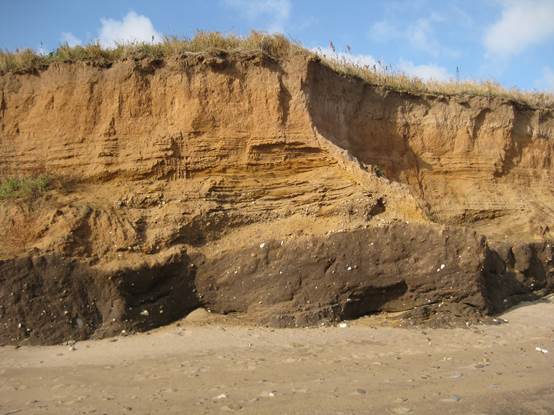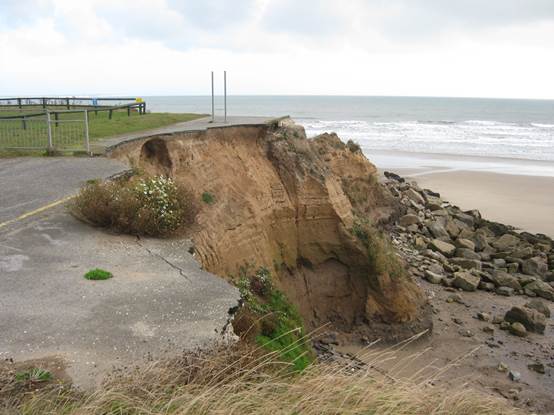Three locations were visited.
1. Sewerby
The well known cliff section west of Sewerby Steps was not too obscured by slips.
The line of intersection of the modern cliff with the Ipswichian cliff was visible and the large rounded chalk cobbles and boulders of the raised beach were clearly seen raised about 1.5 m above the modern beach. The rest of the sequence was patchily exposed. The overlying Skipsea Till was not very accessible here but the fluvio-glacial Sewerby Gravels were well exposed at the top of the cliff.
2. Dane’s Dyke
A clean and accessible section at the base of the cliff between the Chalk and Skipsea Till was exposed on either side of the valley. To the west the top of the chalk just above the modern beach was strongly deformed by small folds and thrusts. [This deformation is now thought to be tectonic and not due to cryoturbation as suggested at the meeting]. The overlying sediment consisted of a massive sheet of chalk debris, “head”, deposited during the summer thaw of the surface layer over permafrost. In the centre of the valley this was overlain by a finely laminated silty clay coarsening up to medium sand, a sequence probably deposited in a proglacial lake.
3. Barmston
After lunch at the Black Bull in Barmston we drove towards the coast until the road disappeared over the cliff. Skirting the cliff edge we stopped to appreciate the view to the north from Flamborough Head to Bridlington with the rising ground of the Wolds behind. This contrasted with the low lying landscape of Holderness with isolated hills, mainly of sand and gravel, barely reaching 30m in height. A fine example of an ice wedge cast was seen near the top of the cliff.
Descending to the beach we noticed a thin black peaty horizon at the base of the modern soil. To the south the cliffs increase in height and expose the Skipsea Till containing numerous and diverse erratics. We noted that this till had an irregular hummocky upper surface in the hollows of which were poorly sorted gravels, often very disturbed and balled up. Marine erosion had picked out low angle shears in the till. Above this till was an upwards coarsening sequence of laminated silty clays with lenticular bedding, fine to medium cross bedded sands, and coarse sand and gravel displaying large scale cross beds (epsilon bedding). The leader suggested that this sequence could be interpreted as glaciolacustrine capped by a Gilbertian style delta which built out into the lake.


